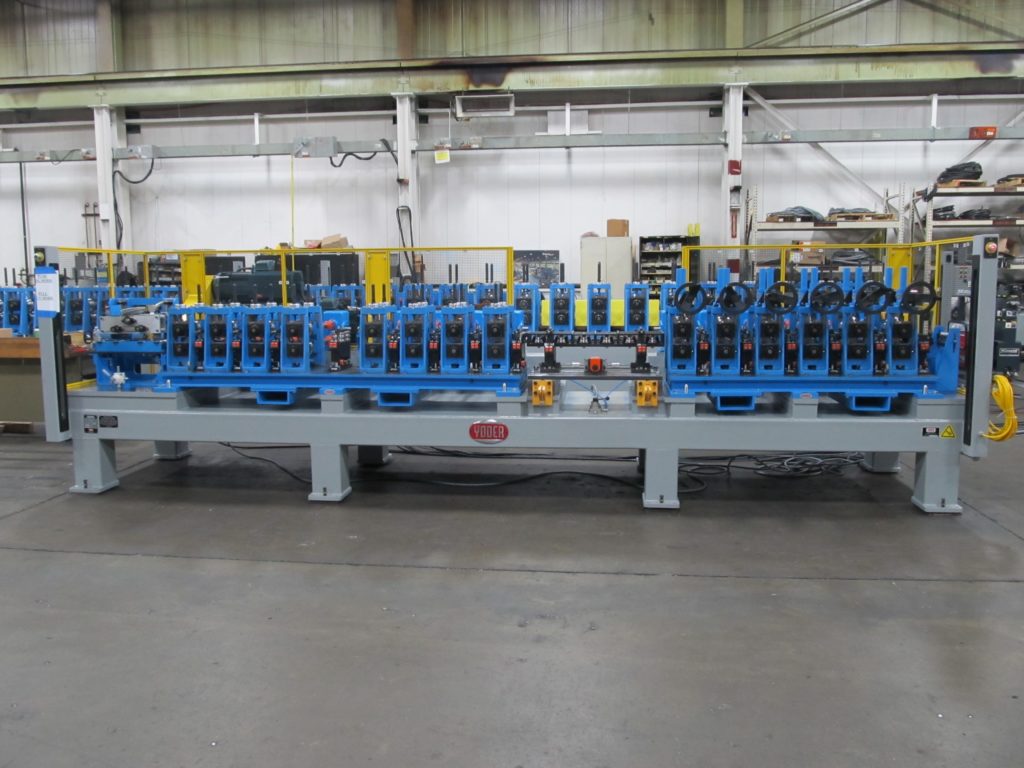The Relationship of Line Accuracy to Line Speed
The two basic questions that any roll former user or potential user are interested in are:
- At what speed can I run the line and then cut off properly?
- How accurately can I cut on the overall length?
These two questions cannot be separated because they have an effect on each other. It naturally follows that the faster the speed of the roll former, the more difficult it becomes to hold a given length tolerance on any particular shape.
Measuring Methods for Cutoff Tooling Positive Type Method
If the roll formed shape must be cut to a length accuracy of + 1/64 inches or less, there used to be no other alternative than to use a positive stop, and it still is the cheapest, most reliable method. I say “used to be no other alternative” because with some of the high-speed presses, especially the air presses now available that can run at very slow speeds (possibly below 75 F.P.M.), a person can hold this tolerance using a photoelectric eye measuring system or a rotary encoder system.
A positive stop is made of a traveling plate on the measuring table that is attached directly to the flying cutoff die by means of a rod. When the part hits the stop plate, the stop plate pulls the die along and the die hits a switch on the bolster, which trips the press.
The only advantage of this type of measuring is the ability to hold close-length tolerances. But that is a big advantage.
The disadvantages of this type of measuring are that, at increased speeds, there is a good chance that light-duty parts will buckle upon hitting the flag. Some light-duty aluminum parts cannot use the positive stop at any economical speed without buckling. Also, at increased speeds, if the part is too strong to buckle it might still flex and bounce on the flag causing variances in the length. There might also be damage to the end of the part at times, depending on the part cross-section. These problems all contribute to keeping line speed down when running a positive stop.
The positive stop is an accurate, simple, measuring system with setup being easy since one is just measuring between the blade and the stop plate to set length without much, if any, further adjustment. It is up to the experience of the designer and operator to determine ahead of time if the cross-section and/or gauge of the part is strong enough to be run economically using a positive stop.
Flag Trip Measuring Method
Another method of measuring is the “flag trip” method, so-called because we normally hit a plate attached to a pivot pin. The whole unit resembles a flag. This method is probably the most widely used, with many variations.
The switch, attached to a housing of one sort or another, is adjustable for the full length of the runout table. When the lead edge of the part hits the flag, the switch trips the cutoff press. The flag then pivots out of the way, letting the part pass.
The advantage of the flag trip method is the fact that you can almost always run any given shape at a much higher speed than you can with the positive stop method. This is because the part runs into no resistance when it hits the flag, and therefore there is no problem of buckling the shape on the runout table.
The flag trip method would always be used if it weren’t for the fact that it results in a greater error of the cutoff length. The accuracy depends on many little things such as the stability of the line speed, the consistency of the flag switch, keeping the stock at 90 degrees to the flag when it hits the flag, etc. However, most important to accuracy is the consistency of the press to repeat, keeping the identical elapsed time from signal impulse to hitting the part with the blade.
All measuring and press controls associated with all measuring systems, besides positive stop systems, should be D.C. filtered. The sine wave variation in AC 60-cycle current can result in a prohibitive error by itself.
As you can see, when using a flag trip, the associated cut-off equipment is much more critical to the accuracy of the line. So, many times, if no more money can be spent on the line, the choice, in order to achieve line accuracy, must be to use a positive stop.





